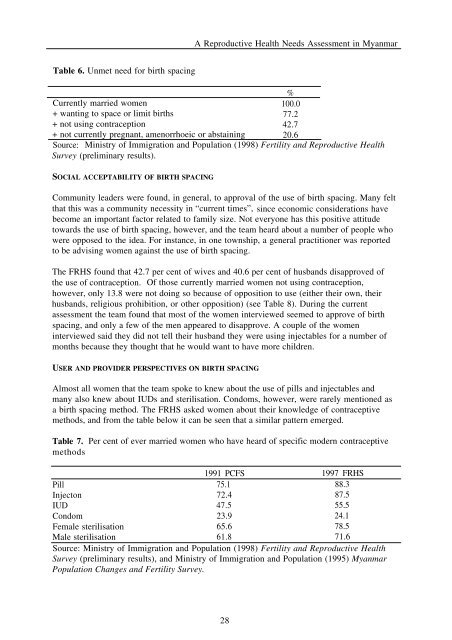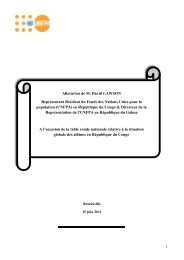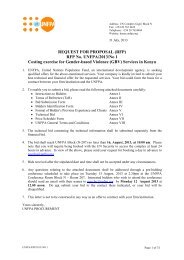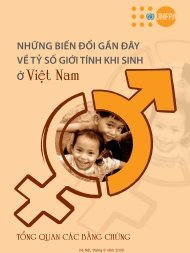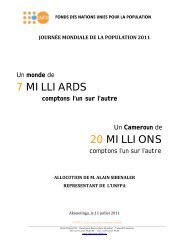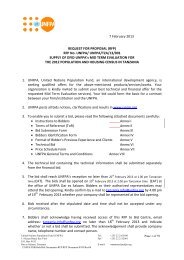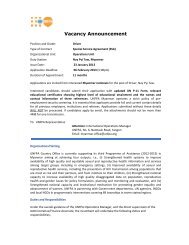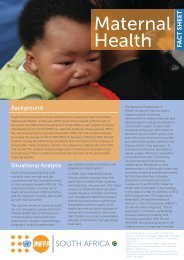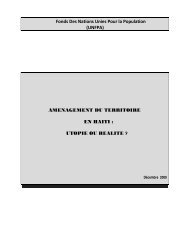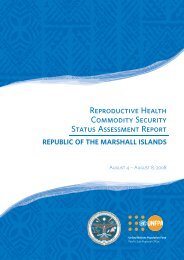A reproductive health needs assessment in Myanmar
A reproductive health needs assessment in Myanmar
A reproductive health needs assessment in Myanmar
You also want an ePaper? Increase the reach of your titles
YUMPU automatically turns print PDFs into web optimized ePapers that Google loves.
A Reproductive Health Needs Assessment <strong>in</strong> <strong>Myanmar</strong><br />
Table 6. Unmet need for birth spac<strong>in</strong>g<br />
%<br />
Currently married women 100.0<br />
+ want<strong>in</strong>g to space or limit births 77.2<br />
+ not us<strong>in</strong>g contraception 42.7<br />
+ not currently pregnant, amenorrhoeic or absta<strong>in</strong><strong>in</strong>g 20.6<br />
Source: M<strong>in</strong>istry of Immigration and Population (1998) Fertility and Reproductive Health<br />
Survey (prelim<strong>in</strong>ary results).<br />
SOCIAL ACCEPTABILITY OF BIRTH SPACING<br />
Community leaders were found, <strong>in</strong> general, to approval of the use of birth spac<strong>in</strong>g. Many felt<br />
that this was a community necessity <strong>in</strong> “current times”, s<strong>in</strong>ce economic considerations have<br />
become an important factor related to family size. Not everyone has this positive attitude<br />
towards the use of birth spac<strong>in</strong>g, however, and the team heard about a number of people who<br />
were opposed to the idea. For <strong>in</strong>stance, <strong>in</strong> one township, a general practitioner was reported<br />
to be advis<strong>in</strong>g women aga<strong>in</strong>st the use of birth spac<strong>in</strong>g.<br />
The FRHS found that 42.7 per cent of wives and 40.6 per cent of husbands disapproved of<br />
the use of contraception. Of those currently married women not us<strong>in</strong>g contraception,<br />
however, only 13.8 were not do<strong>in</strong>g so because of opposition to use (either their own, their<br />
husbands, religious prohibition, or other opposition) (see Table 8). Dur<strong>in</strong>g the current<br />
<strong>assessment</strong> the team found that most of the women <strong>in</strong>terviewed seemed to approve of birth<br />
spac<strong>in</strong>g, and only a few of the men appeared to disapprove. A couple of the women<br />
<strong>in</strong>terviewed said they did not tell their husband they were us<strong>in</strong>g <strong>in</strong>jectables for a number of<br />
months because they thought that he would want to have more children.<br />
USER AND PROVIDER PERSPECTIVES ON BIRTH SPACING<br />
Almost all women that the team spoke to knew about the use of pills and <strong>in</strong>jectables and<br />
many also knew about IUDs and sterilisation. Condoms, however, were rarely mentioned as<br />
a birth spac<strong>in</strong>g method. The FRHS asked women about their knowledge of contraceptive<br />
methods, and from the table below it can be seen that a similar pattern emerged.<br />
Table 7. Per cent of ever married women who have heard of specific modern contraceptive<br />
methods<br />
1991 PCFS 1997 FRHS<br />
Pill 75.1 88.3<br />
Injecton 72.4 87.5<br />
IUD 47.5 55.5<br />
Condom 23.9 24.1<br />
Female sterilisation 65.6 78.5<br />
Male sterilisation 61.8 71.6<br />
Source: M<strong>in</strong>istry of Immigration and Population (1998) Fertility and Reproductive Health<br />
Survey (prelim<strong>in</strong>ary results), and M<strong>in</strong>istry of Immigration and Population (1995) <strong>Myanmar</strong><br />
Population Changes and Fertility Survey.<br />
28


